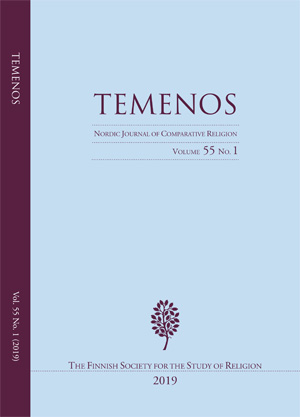The Dagda, Thor and ATU 1148B
Analogues, Parallels, or Correspondences?
DOI:
https://doi.org/10.33356/temenos.83427Abstract
Since ancient times celestial thunder gods have been a familiar feature in mythologies throughout the Indo-European language area. Their Irish counterpart, the Dagda, is a major personage at the centre of the Mythological Cycle, and his possible connections to the Scandinavian god Thor are examined here. Following a brief section dealing with questions of methodology, points of comparison are addressed which include the two gods’ common primary role as defenders of their realm; their place in the assembly of gods; their principal weapons and implements (iron club/hammer/harp, cauldron); their associations with cosmology and artisans; and their visits to the abode of their monstrous adversaries, incorporating elements of the burlesque. Both gods appear in versions of the international tale ATU 1148B ‘The Thunder Instrument’ (Thor in the Old Norse poem Þrymskviða, and the Dagda’s recovery of his harp from the Irish Mythological Cycle), and the nature of the parallels between the two versions is examined. The question of a borrowing during the Viking era, or of an inherited body of tradition possibly from Indo-European times, is discussed: the international tale type also leads to the myth, at a further temporal and geographical remove, of the Greek god Zeus and the theft of his thunderbolts. A proposed sequential account of the development and evolution of both gods from remote antiquity is provided.
Downloads
Published
How to Cite
Issue
Section
License
Copyright (c) 2019 Temenos - Nordic Journal of Comparative Religion

This work is licensed under a Creative Commons Attribution-NonCommercial-NoDerivatives 3.0 Unported License.
Author's Guarantee
- The Author acknowledges that the Work will be publicly accessible on the Internet and that such access will be free of charge for the readers.
- The Author guarantees that the Work is her/his original work that has not been published before and cannot be construed as copying or plagiarism. Furthermore, the Author confirms that the Work contains no statement that is unlawful, defamatory or abusive or in any way infringes the rights of others.
- The Author confirms that she/he has secured all written permissions needed for the reproduction in the Publication of any material created by a third party.
User Rights
Under the CC BY 4.0 license, the Author/s and users are free to:
- Share — copy and redistribute the material in any medium or format,
- Adapt — remix, transform, and build upon the material for any purpose, even commercially,
- However, the Work must be attributed to the original Author and source of publication.
The license of the published metadata is Creative Commons CCO 1.0 Universal (CC0 1.0)
Author Rights
The Authors maintain the right to:
- copyright, and other proprietary rights relating to the Work,
- the right to use the substance of the Work in future own works,
- the right to self-archiving/parallel publishing (publisher's PDF allowed).
Rights of Publisher
- The Publisher reserves the right to make such editorial changes as may be necessary to make the Work suitable for publication in the publication, e.g. style of punctuation, spelling, headings and the like.
- The Publisher will publish the Work if the editorial process is successfully completed and reserves the right not to proceed with publication for whatever reason.
- The publication entitles the author to no royalties or other fees. This agreement will be governed by the laws of Finland.






